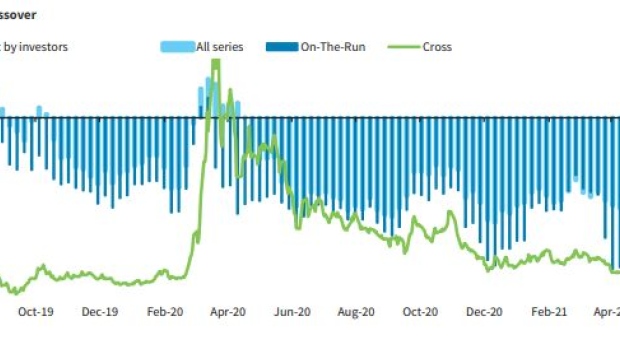Jun 18, 2021
Investors Dump Hedges on Junk Bonds Even as Europe Defaults Loom
, Bloomberg News

(Bloomberg) -- Investors are sitting astride the largest junk bond market in Europe’s history without a rainy-day fund. Even credit bulls worry that may not be such a good idea.
Hedges on the Markit iTraxx Crossover index were effectively neutralized after investors jettisoned $1.8 billion of credit-default insurance in the week ending June 11, according to analysis by Barclays Plc. That makes positioning the most bullish -- and exposed to risks -- as it’s been in a year.
There are many reasons to be optimistic about bonds of risky companies. Central banks continue to prop them up by ensuring easy and cheap access to credit markets while a global growth rebound will feed corporate revenues, making it easier to carry large debt loads.
But there are just as many reasons to worry. Rates are headed up as inflation comes roaring back, leverage is at an 11-year high compensation for these risks is the slimmest in three years.
“The market is long because it has loads of cash to deploy and fundamentals are quite strong,” said Vincent Benguigui, a portfolio manager at Federated Hermes, which oversees $625 billion. “It’s not a comfortable long though.”
That cash is on display in the size of the high-yield market: it just notched a record 461 billion euros ($550 billion), thanks to the pandemic-induced borrowing binge and a wave of fallen-angel downgrades of companies into junk. It’s dwarfed by some $1.5 trillion of speculative-grade bonds traded in the U.S., but has grown from zero in 1998.
Not everyone is dumping short positions. BlueBay Asset Management fund manager Geraud Charpin has been adding to bearish bets through credit indexes. He sees the next pressure point in cyclicals and industrial companies that binged on debt in a central bank-fueled financing bonanza.
“I think the market should be taking bigger short positions in fact,” Charpin said in an interview. “It misses a view.”
While he’s in the minority, even credit bulls are cautioning against running unhedged positions while pricing is so tight. Bank of America Corp. strategists advised clients to hedge credit portfolios at the start of June.
Next Downturn
For now, there are few signs of stress. Default forecasts for high-yield companies remain low, with a 2% to 3% range expected in 2021 compared to 3.3% last year.
But that’s set to change as central banks start to taper asset-purchase programs that kept shaky borrowers afloat during the pandemic.
Already, high-yield defaults in Europe have overtaken the U.S., according to S&P Global, and the gap is forecast to widen by the first quarter of 2022 with Europe’s default rates reaching 5.25%.
“The next downturn will hit the market much harder as we have more leverage in the system and higher chances of mass defaults due to inflation risks sending rates higher,” said Jochen Felsenheimer, managing director at XAIA Investment in Munich.
In the short-term, faster-than-expected inflation could spark wider spreads, Felsenheimer warned, and with cushions against losses so thin, it would take a widening of 60 basis points to wipe out annual profits on the high-yield CDS index.
“Would I sleep better being long or short the market right now?” Charpin asked. “Short is my answer.”
©2021 Bloomberg L.P.